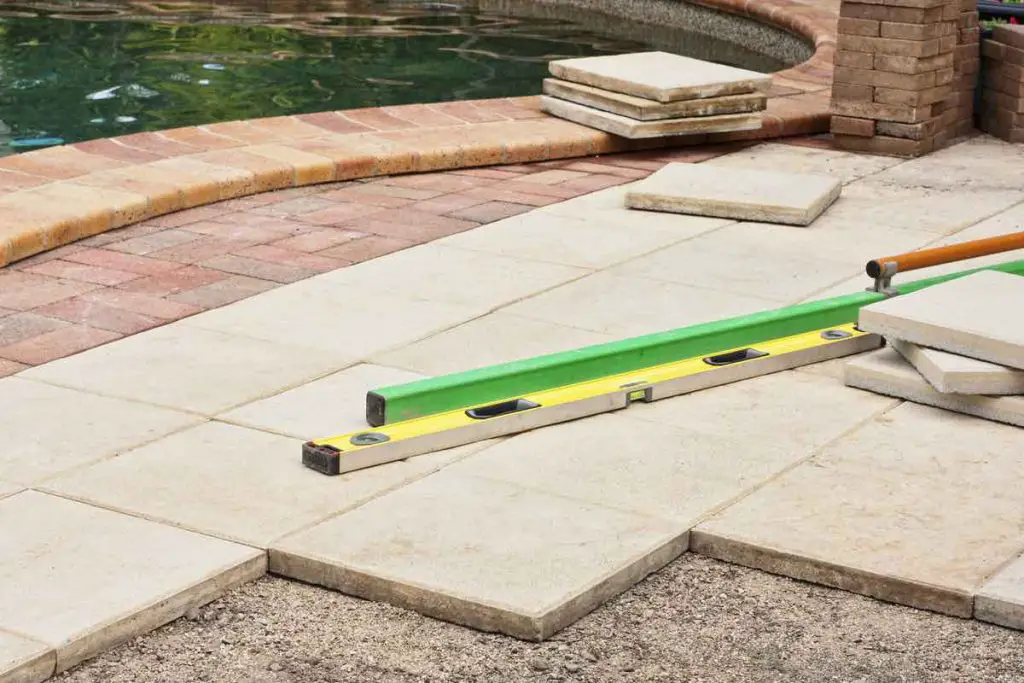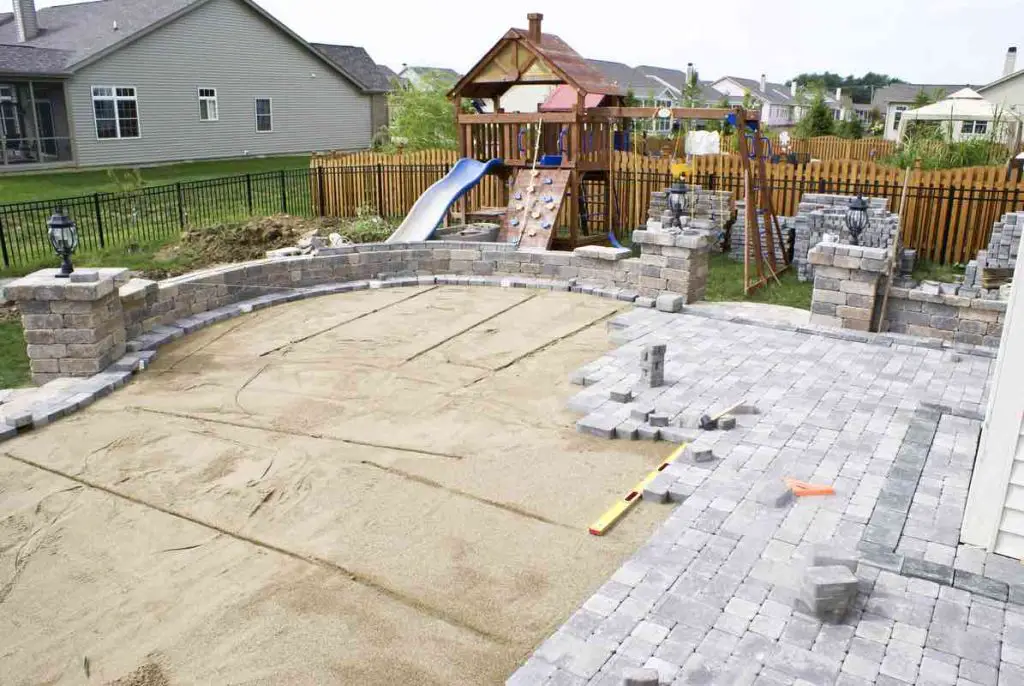People like using pavers to decorate their pools due to their durability; they consist of natural stone, concrete, or bricks. Pavers are also versatile in terms of the designs one can implement. However, sometimes pavers sink.
Pavers around a pool can sink due to factors like water damage and poor installation, among others. Sunken pavers pose a great risk to pool uses; they increase the risk of slips and falls that can cause serious injuries. They can also cause structural damage to the pool, leading to costly repairs.
It is vital to understand why the pavers around your pool are sinking. This will help you make informed decisions on how to undertake repairs. Continue reading to understand the main reasons pavers sink:

1. Poor Installation
Having poorly installed pavers can be the reason why you notice them begin to sink. Signs of poor installation include having pavers installed on top of bare soil, which contributes to their instability. Proper installation of pool pavers requires a solid and level base material consisting of either compacted gravel or coarse sand.
Another sign of poor installation is a lack of compacted sand under the pavers. Uncompacted sand contains numerous air gaps, which slowly close up with time as the pavers exert their weight on it, resulting in their sinking. Pavers installed in uneven patterns are more likely to shift and sink since they do not adhere to each other as effectively.
In other instances, contractors forget or neglect to restrain the edges of the paving blocks. That means pressure acting externally on the edges can cause their displacement or sinking. It is essential to ensure your contractor reinforces the edges of your pool pavers to prevent such outcomes.
Repairing pavers that sink due to poor installation can be costly as you may have to remove all the pavers and redo the base. Thus, it is advisable to avoid installing the pavers yourself (DIY) or hiring installers with insufficient experience.
2. Ground Structure and Composition
The structure and composition of the ground upon which you build your swimming pool can also contribute to the pavers sinking. For instance, areas with steep slopes can experience soil displacement during extreme weather events that can interfere with the base material under the pavers resulting in the sinking.
Places with soft and loose sands, near beaches, and semi-arid areas, can also experience similar issues during geological events like earth tremors.
Moreover, places where uprooting trees and tree roots is necessary to allow construction usually have air pockets. Failure to fill in the spaces and compact them can result in the pavers sinking after a while as the soil and base material beneath them settle.
Lastly, in areas with freezing winters, the soils freeze throughout winter and thaw as spring begins. The freezing causes soil expansion, while thawing causes soil contraction, which can cause pavers to sink.
For areas with steep slopes and soft sands, having compact and reinforced base material is necessary. A concrete base material will help prevent damage caused by freezing and thawing.
3. Loose Sand
Sand is a vital component in the placement of pavers since contractors use it as a base material to support the pavers and fill in the joints between individual pavers. Consequently, as you continue to use your pool, the sand can loosen and begin to spill into the pool or around the compound.
As the loss of sand continues, the pavers on top will begin to sink to fill the space left. Moreover, the pavers will shift due to loss of sand in the joints, resulting in uneven patterns that contribute to more sinking. However, you can prevent or rectify the issue by asking your contractor to use epoxy sand that holds together the sand, negating the need to replace lost sand.
4. Water Exposure
Water exposure is common in areas that receive high amounts of rainfall. Consequently, such substantial levels of rainfall cause water erosion, carrying away sand used to make the base material and resulting in the pavers sinking.
Still, rainfall is not the only source of water exposure and erosion. This can also result from structural issues related to the pool’s construction.
If the pool has a broken pipe that leaks water into its surrounding, this can cause the pavers closest to the edge of the pool to sink. Moreover, water exposure also occurs in areas that receive heavy snowfall during the winter, subsequently thawing and draining between the pavers into the base material.
To prevent these scenarios, inspect your property’s drainage features before constructing the pool and regularly maintain the pool to avoid broken pipes. You should also apply epoxy sand on the exterior of the pavers to prevent water seepage into the base material.
5. Growth of Fungus and Mold
As already mentioned, exposure of swimming pool pavers to water is another reason why the pavers are sinking. Additionally, water creates a conducive environment for the growth of black fungus and green mold.
Fortunately, you can resolve the issue by using a mild detergent on the affected area and a garden hose to clear the mold and fungus.
If they persist, you should call a professional to inspect the pool’s drainage system thoroughly.
To learn more about mold growth on pavers and how you can eliminate it, check out the complete guide I’ve written about the topic. [How to Get Rid of Black Mold on Pavers Around a Pool]
6. Growth of Weeds
Water exposure also promotes the growth of weeds by carrying away sand, thereby providing space for weed seeds to germinate and the moisture to sustain them. Using masonry sand between paver joints also makes the growth of weeds easier.
You can prevent the growth and spread of weeds around your pool using a non-oil-based spot weed killer. Alternatively, you can hire a contractor to apply epoxy sand on the pavers, which locks the sand between the pavers in place.
7. Ant Infestations
Ants prefer burrowing into sand to create nests where they can reproduce hence the reason they can be a nuisance around the pool. The sand used as base material and joint fillers for pavers provide the perfect environment for ants to settle in.
Thus, when you notice your pavers starting to sink, ensure you check their surroundings for anthills. Once you confirm their presence, use insect repellent to kill or disperse them. If the ant infestation is spread throughout the pool’s pavers, hire an insect treatment service to handle the task professionally.
Alternatively, you can avoid buying repellent or hiring a treatment service by using epoxy sand to lock the sand.

Sources
- HIC Verified Local Professionals: Why are my pavers sinking?
- Miami New Constructions How: What Causes Pavers to Sink? – What to Know – September – 2022
- Pools By Bradley: Good Information You Need To Know About Paver Decks
- Realty Times: Correcting Common Problems Regarding Paving Around Pools
- Silive: Ask The Expert: Why Are My Pavers Sinking?

